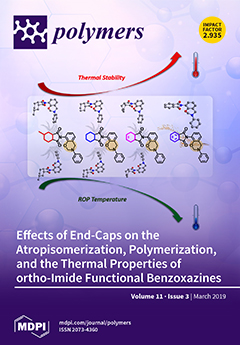Ethylene-
co-norbornene copolymers were synthesized by a dual catalyst system at three concentrations of norbornene in the feed and variable amounts of ZnEt
2, as a possible chain transfer agent. The dual catalyst system consists of two
ansa-metallocenes, isopropyliden(η
5-
[...] Read more.
Ethylene-
co-norbornene copolymers were synthesized by a dual catalyst system at three concentrations of norbornene in the feed and variable amounts of ZnEt
2, as a possible chain transfer agent. The dual catalyst system consists of two
ansa-metallocenes, isopropyliden(η
5-cyclopentadienyl)(η
5-indenyl)zirconium dichloride (
1) and isopropyliden(η
5-3-methylcyclopentadienyl)(η
5-fluorenyl)zirconium dichloride (
2), activated with dimethylanilinium tetrakis(pentafluorophenyl)borate, in presence of TIBA. Values of norbornene content, molecular mass, glass transition temperature, and reactivity ratios
r11 and
r21 of copolymers prepared in the presence of
1+
2 are intermediate between those of reference copolymers. The study of tensile and elastic properties of ethylene-
co-norbornene copolymers (poly(E-
co-N)s) gave evidence that copolymers were obtained in part through transfer of polymer chains between different transition metal sites. Mechanical properties are clearly different from those expected from a blend of the parent samples and reveal that copolymers obtained in the presence of
1+
2 and ZnEt
2 consist of a reactor blend of segmented chains produced by exchange from
2 to
1 and
1 to 2 acting as the ideal compatibilizer of chains produced by the chain transfer from
1 to
1, and from
2 to
2.
Full article






